listen, it’s been a mere week since this game came out and I started playing yesterday; that qualifies as punctual for me
For the benefit of anyone who hasn’t decided yet whether they want to buy this game, here are some thoroughly de-spoilered opinions:
It’s very different; it’s quite unlike the traditional Pokémon formula. Follows Pokémon Go and Let’s Go Pikachu/Eevee in putting the emphasis on catching and releasing a lot of Pokémon to progress; follows Sword and Shield in putting the human characters and their motivations front-and-centre a bit more than previous titles. A lot more open-world-action-game-y than Sword and Shield ever tried to be. Cares a great deal about Pokémon’s exploration/discovery themes. Sometimes Pokémon try to murder you. Battles with other trainers are not completely absent, but so far a very minor aspect of the game, appropriately enough given its premise and setting; it’s mostly about wild Pokémon. So far I like it; the characters are great, the new Pokédex system is great, the environments (both natural and human) are very pretty if you care about that. I mean, I have to reserve full judgement until… well, if my previous record on Pokémon games is anything to go by, until about 10 years have passed and I’ve played it all the way through multiple times, but yeah, so far it seems good.
Also, while playing this game, I was watching an episode of House, M.D. (episode 8.8) in which the title character remarks – out of nowhere and to the utter bafflement of everyone else in the room – that “Arceus created a universe with three states of matter.” It’s totally in-character; House spends a lot of time playing video games and he enjoys saying cryptic things just to mess with people; I just thought it was a fun coincidence that I’d never seen that particular episode before and happened to watch it during my first day with Legends: Arceus.
Anyway, this concludes my not-a-review; from this point on, HERE BE SPOILERS (but only for what I’ve played so far, which is honestly not that much, so unless you’re observing absolute blackout protocol it’s probably fine). Let’s talk about the first… chunk… of this game, and some things I thought about it.
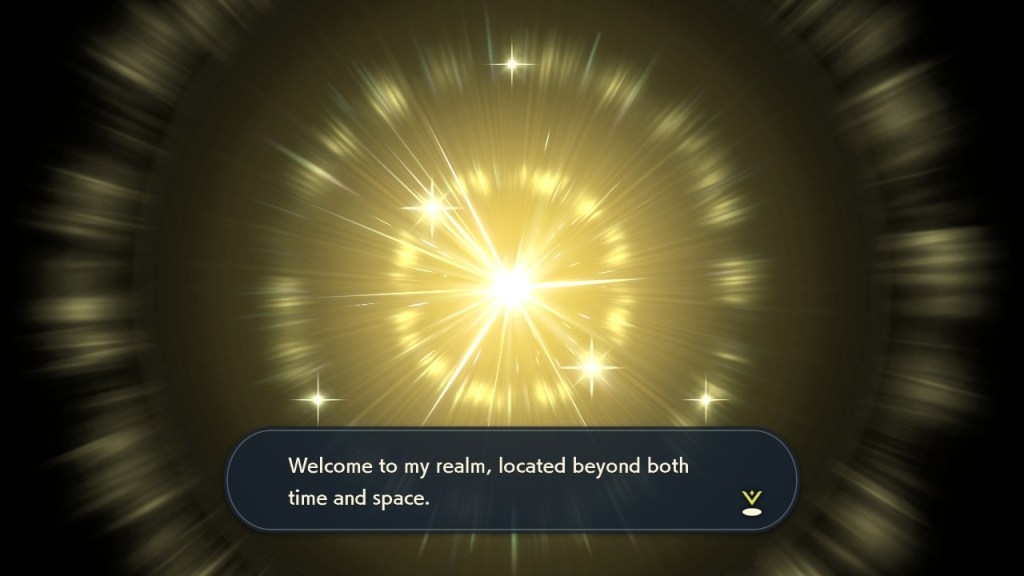
The way the player character ends up in the Hisui region is a little different from what I was expecting: apparently Arceus just fµ¢£in’… grabbed some kid and plopped them down in Hisui. You’re not from the time period in which the game is set; heck, I’m not even sure you’re from the Pokémon world at all (shades of Mystery Dungeon, perhaps). This is why you have a weird-looking Arceus-themed cell phone, which seemed like a bizarre choice when it was revealed in promotional material. It’s not technology that actually exists in old Hisui – you just had a cell-phone because you’re a modern kid, and Arceus made it magic in order to put its finger (…hoof?) on the scales for you a little. Which, frankly, seems like the least it could do. Obviously there’s no one in old Hisui you can call on your one-of-a-kind magic god-phone, so it mostly just serves as your map (at least, so far; maybe it does other stuff when you get further in the game). This is something that a lot of other games are happy to just stick in the UI with no diegetic explanation for how it works, although admittedly Pokémon games have always explicitly tied your map to an object your character actually owns, either as a paper “Town Map” or as a function of your Pokédex. Weirdly, I think this choice maybe says something about how ubiquitous and essential cell-phones have become to people’s everyday lives: when Game Freak’s developers imagine a magic space-deer plucking you out of your normal life and dumping you in 19th century Hokkaidō surrounded by monsters, they don’t imagine your phone getting lost or becoming useless; they imagine a way for the phone to stay useful and actually give you an edge over other characters (who are presumably using a combination of hand-drawn maps and memory).
Arceus also gives us a task: meet every Pokémon in Hisui, and you’ll find your way back to me. The implication seems to be that, if we complete the Pokédex, our reward will be being restored to our proper time and place (again, shades of Mystery Dungeon… in which the player character ultimately refuses to go home because their new friends are more important; I doubt the twist in Legends: Arceus will be exactly the same, but I assume there will be one).
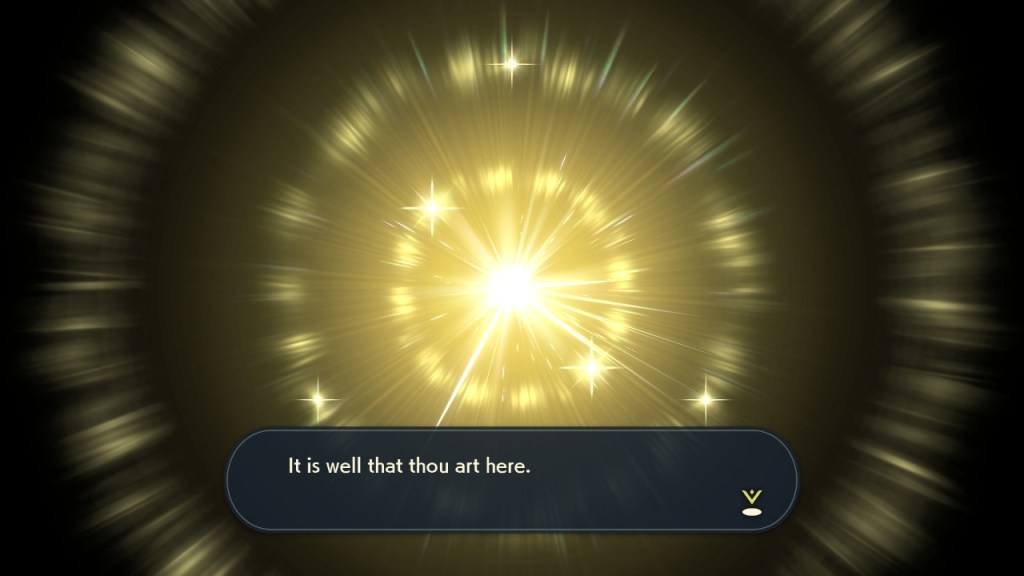
Also Arceus uses “thee” and “thou” to demonstrate that it’s from Ye Olde Tymes. Very important.
So Arceus wildly yeets us into Hisui and we land, fortunately, on a quiet beach where nothing is trying to kill us. Here we meet the esteemed Professor Laventon, who gets us back on our feet. Laventon is widely-travelled and has three Pokémon that he has brought with him from other regions he’s visited: Rowlet from Alola, Cyndaquil from Johto and Oshawott from Unova. They’ve escaped from his lab, apparently because they somehow sensed the player character falling from the sky and wanted to make sure we’d get an appropriate welcoming committee, but now he needs help getting them back in their balls. This is the tutorial for how to use Legends’ Pokéballs, but also sets up some important stuff about the setting: because Pokéballs are a recent invention, most people don’t know how to use them, and because Pokémon trainers are relatively rare, most people are afraid to get close to Pokémon (which are, after all, unpredictable magic monsters who can make an exciting range of lasers and explosions).
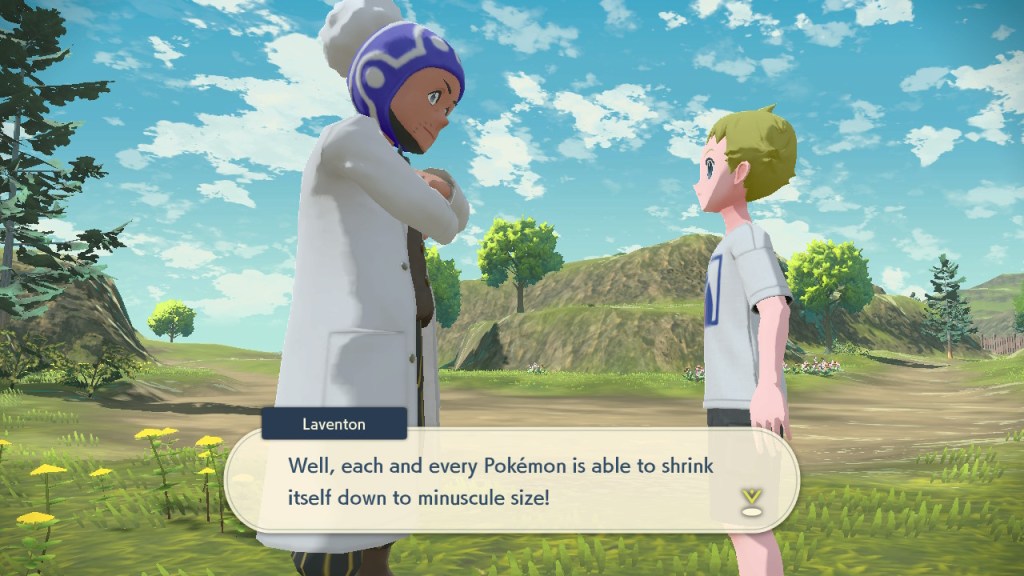
Okay, this remark of Laventon’s is quite interesting. I think a lot of people (including my friends at I Chews You, the podcast about cooking and eating Pokémon) were quite surprised and alarmed by the implication that, actually, Pokéballs aren’t mysterious sci-fi technology after all; rather, Pokémon themselves are somehow inherently collapsible. And I think that confusion is reasonable; after all, Pokémon media doesn’t traditionally go into a lot of detail about how the hell Pokéballs are supposed to work. This actually is precedented, though; there is an old Japanese-only book from the Red and Green era, only recently translated into English (and by the great Nob Ogasawara, no less), which has an absolutely fantastic story about the origin of Pokéballs. I quote: “In 1925, Professor Nishinomori [Japan’s first great Pokémon scientist] was experimenting on his Primeape by administering drugs to try and extract its angry energy. But in his old age, he lost some control of his senses and accidentally gave Primeape TOO MANY DRUGS [my emphasis… because, come on], weakening it to the point where Primeape curled up like a foetus and fit into the professor’s glasses case.” Obviously this isn’t “canon” or whatever in any precise, literal way, because Legends: Arceus is clearly set well before 1925, but the point is that, well… they’re “pocket monsters”; the idea that the ability to shrink is a property of the Pokémon themselves, not the balls, has always been lurking in the background.
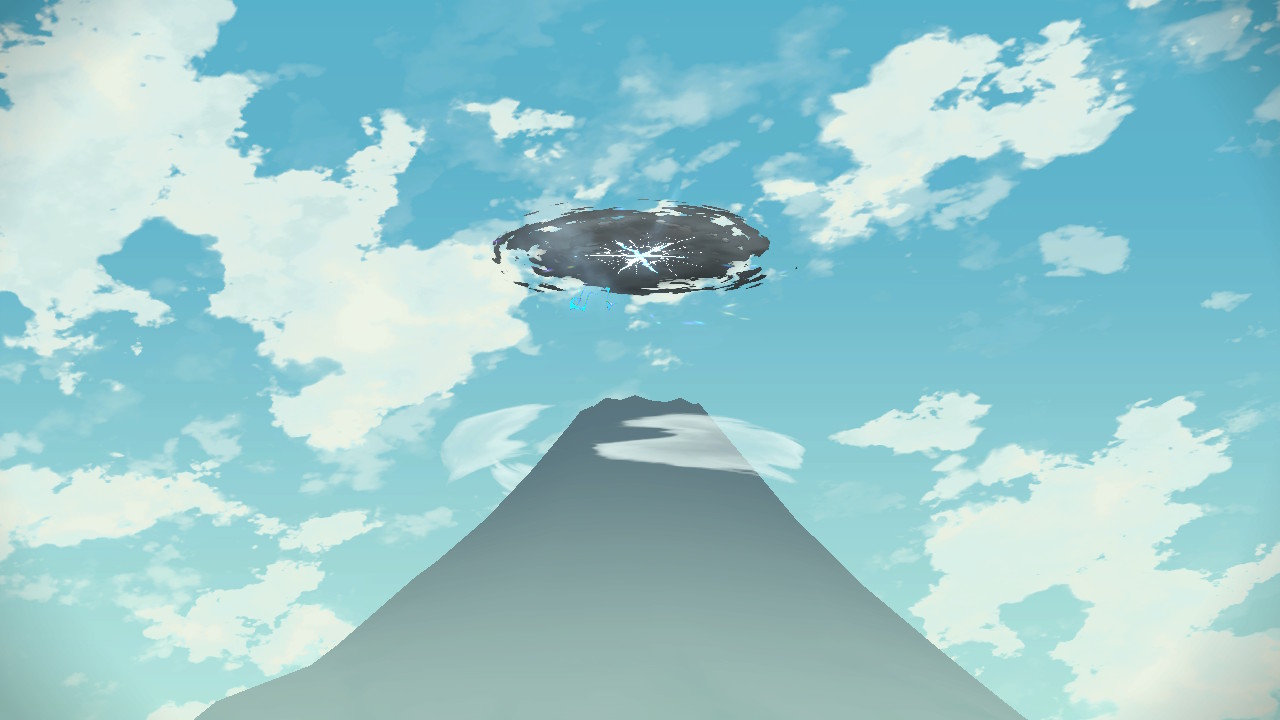
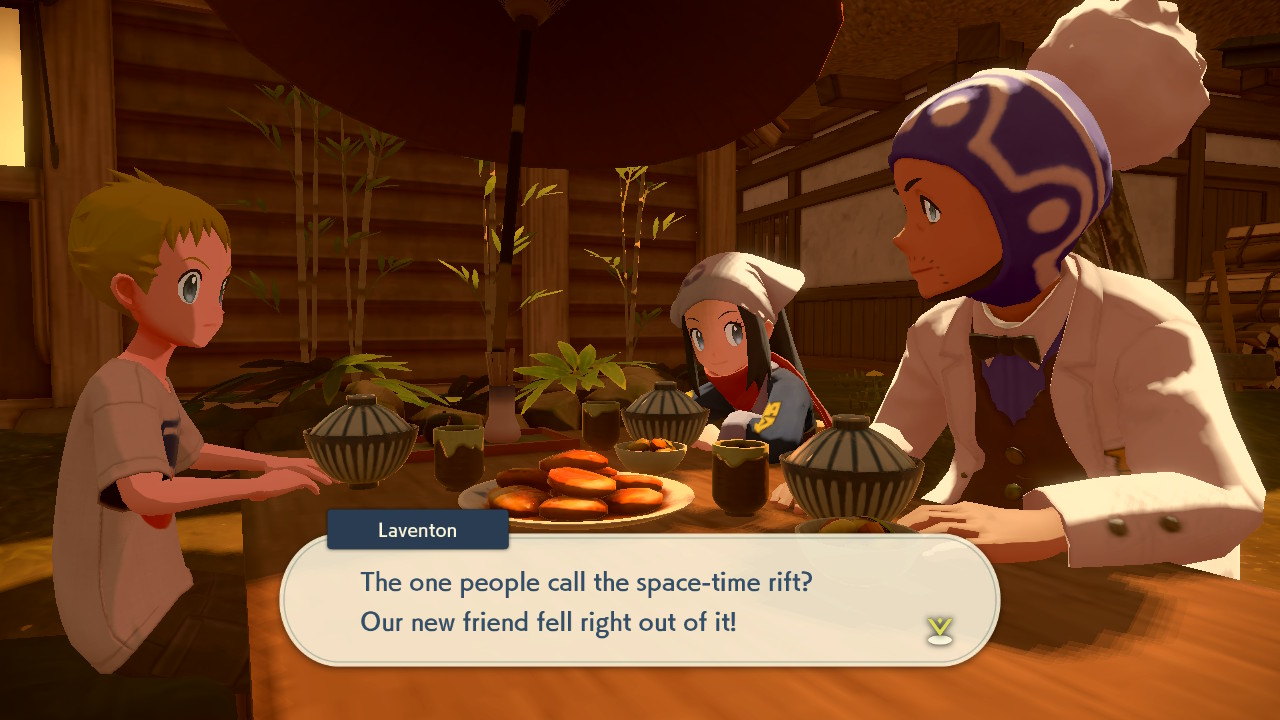
There is a terrifying vortex of doom above Mount Coronet, and it is apparently this through which the player was yeeted. The terrifying vortex of doom is supposedly normal for Hisui and no cause for concern, and the indigenous people of the region believe that it leads to the realm of their deity, “Almighty Sinnoh” (which I believe the pre-release promos either said or implied is their name for Arceus). Lots of ancient cultures believed that their gods lived at the peaks of important mountains, but I have to admit, these people have some unusually compelling evidence for that belief.

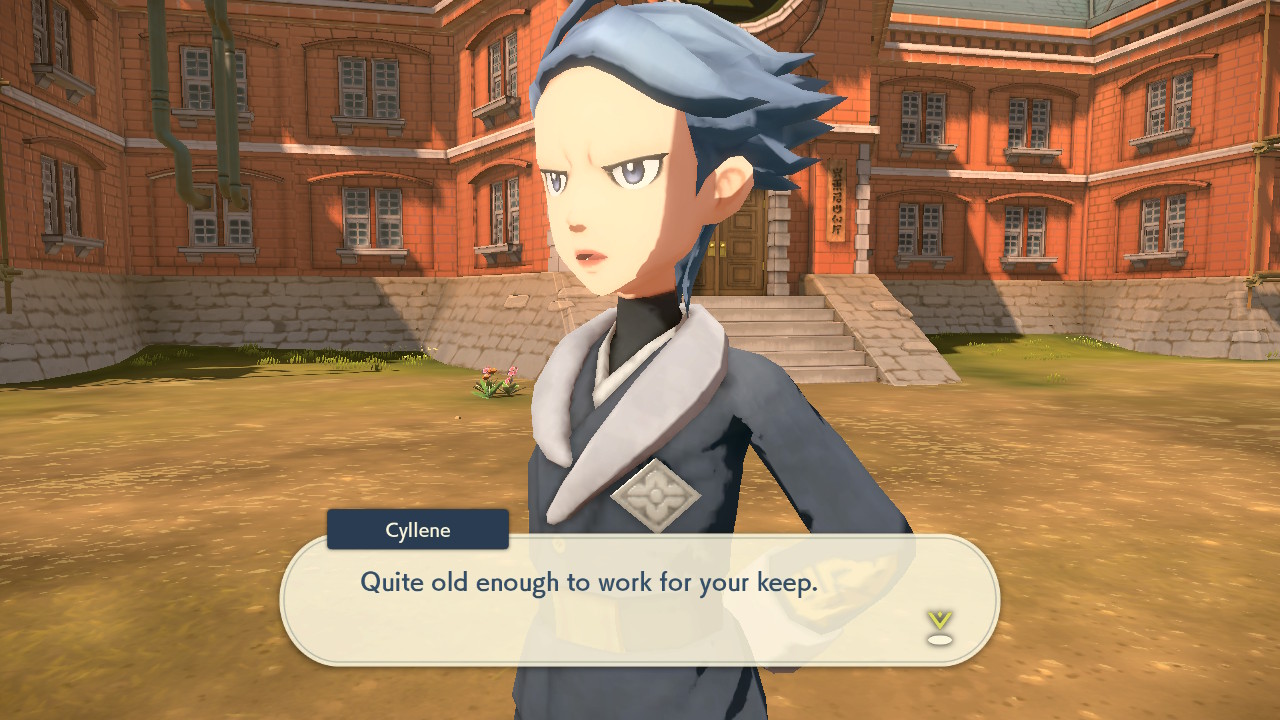
Upon reaching the settler town, Jubilife Village, Professor Laventon introduces us to Cyllene, Captain of the Survey Corps, one of six branches of the “Galaxy Team” that leads the settlement (the others are the Agriculture, Security, Supply, Construction and Medical Corps). We also meet the opposite-gender player character (Akari in my case, Rei if you’re playing as a girl), who is a junior member of the Survey Corps. Cyllene makes it clear that we’re welcome to stay… if and only if we pull our weight: “the Galaxy Team does not have the means to provide for those who only take without giving” (shades of Lysandre in this line). If we’re good enough to work for the Survey Corps, we can stay; if not, we get left in the wilderness and probably starve to death or get eaten by wild Pokémon or something.
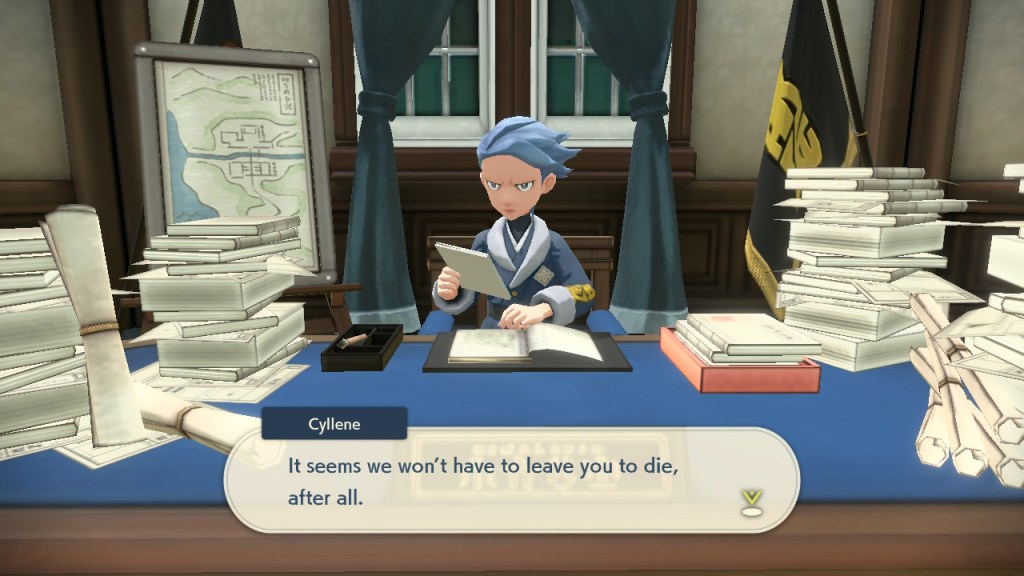
Cyllene is interesting. To be honest I don’t think she ever actually intended to kick you out and leave you to die; I think she just has an unusually dark sense of humour, a phenomenal deadpan and absolutely no conception of how seriously people take the things she says. She’s dedicated, efficient, clearly overworked and, apparently, prone to stress-eating – I think the game slips in this detail to emphasise that her stern, emotionless demeanour is more of a role she plays (the role she thinks the settlement needs her to play) than who she is. Her test to see whether the player deserves to join the Survey Corps is similar: she tells us to go out into the wilderness and catch three different kinds of Pokémon. By the Galaxy Team’s standards, this is considered very difficult for a newbie with no training; Akari is shocked that Cyllene expects so much of the player. But, as Cyllene points out, we’ve already caught three different kinds of Pokémon unaided – Laventon’s three starters. She knows this is within our capabilities; from that perspective, it’s kind of a softball assignment.
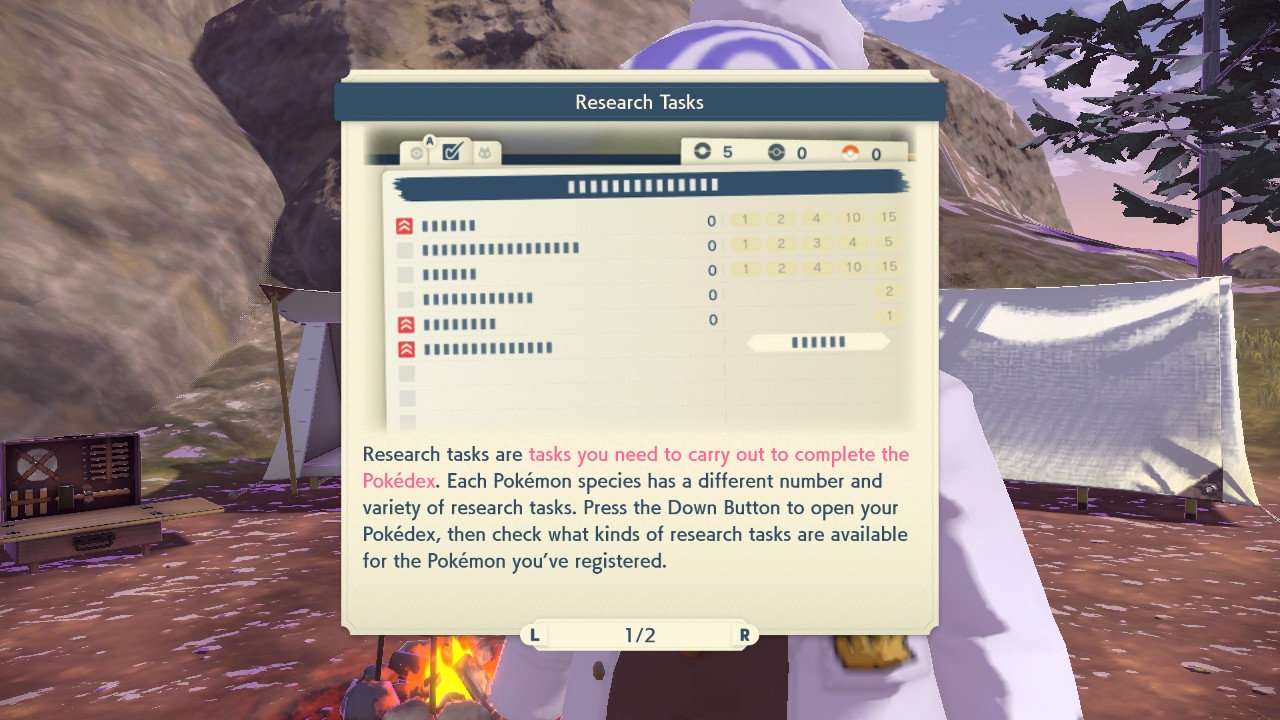
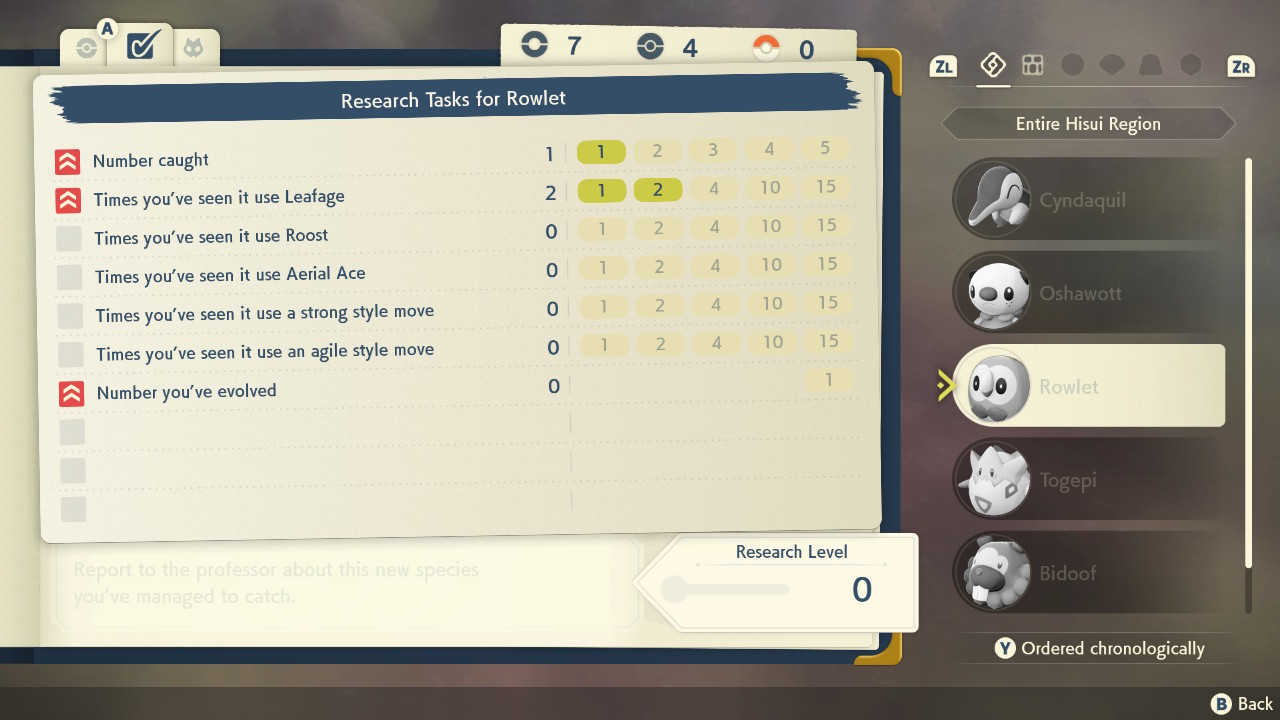
So we pick up a starter (Rowlet FTW) and head out into the wilderness with Laventon and Akari to learn what the hell we’re supposed to be doing. The Galaxy Team doesn’t know jack about the Pokémon of the Hisui region, and it’s the Survey Corp’s job to remedy that, but catching just one Pokémon of each species isn’t going to be enough. There’s a series of tasks for each species, most of them sequential (catch 1, catch 3, catch 6, etc.), of which we need to complete 10 in order to figure out what its deal is. For most species we can learn more about them by catching a bunch of them, beating a bunch of them in battle, observing them as they use specific moves (which means, logically enough, that a good way to learn about a Pokémon is to catch one and use it), or defeating them with super-effective attacks of specific types. For some species we need to feed them in the wild, or catch multiple forms, or catch them from stealth, or catch unusually large or small specimens, or catch them at specific times of day. And for a few, we need to complete specific quests, like dealing with a group of Bidoof that are pestering the village. In the absence of other trainers to beat up and steal money from, catching Pokémon and conducting research is the main way we earn money in this game; it’s also how we earn the respect of our colleagues and move up the ranks within the Survey Corps.
Reader Legdendairy dropped a message in my question box last week, saying that some stuff in Legends: Arceus reminded them of ideas from my ancient “If I Were In Charge” series, and I think this is what they had in mind. One thing I wanted to do was put the Pokédex quest front-and-centre, since it’s theoretically the player character’s real goal in pretty much every core series Pokémon game, and the way I wanted to do that was by including more side-quests, tasks and missions that gave story-based opportunities to learn about different Pokémon species. Writing material like that for an entire Pokédex’s worth of species would be a hell of a job, but it looks like Legends is trying to do it for at least some of them, and provide a variety of appropriate generic tasks for all the rest. So it stands to reason that I think this system is pretty cool.
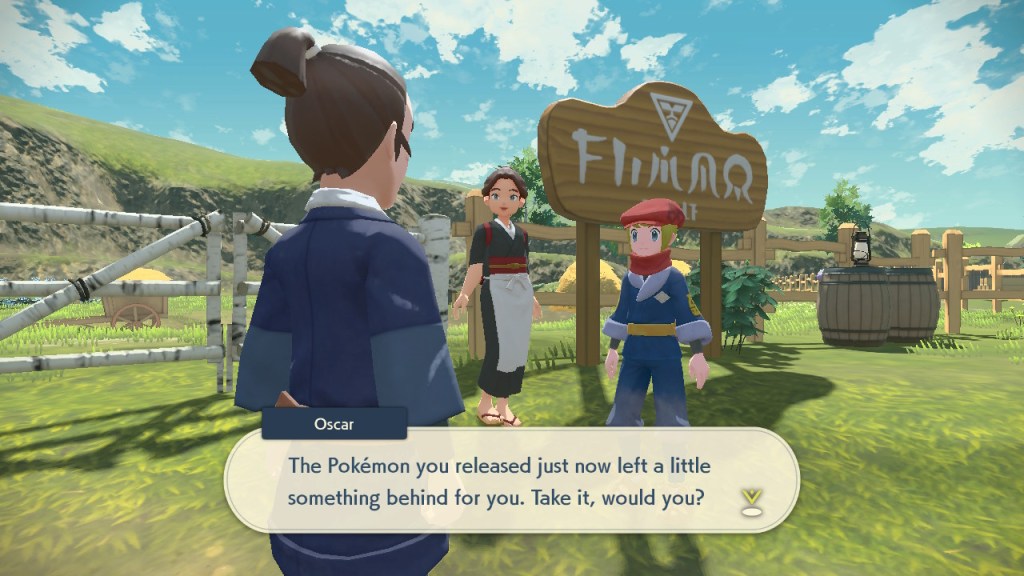
Another neat little detail is that Pokémon you release will leave behind little gifts for you: Grit Dust, Grit Gravel and Grit Rocks, the items you use for EV-training your Pokémon (unlike previous games’ vitamins, these items are generic and can be used to improve any stat). Giving you a reward for releasing Pokémon emphasises that the game expects catch-and-release to be a standard routine, and that there’s no hard feelings on the part of the Pokémon you’re sending back to the wild. I think that’s a good little bit of design. Also nice is that, because computers haven’t been invented yet, Pokémon in excess of your 6 team members are sent to chill out in the village pastures, rather than being digitised and stuffed into the internet.
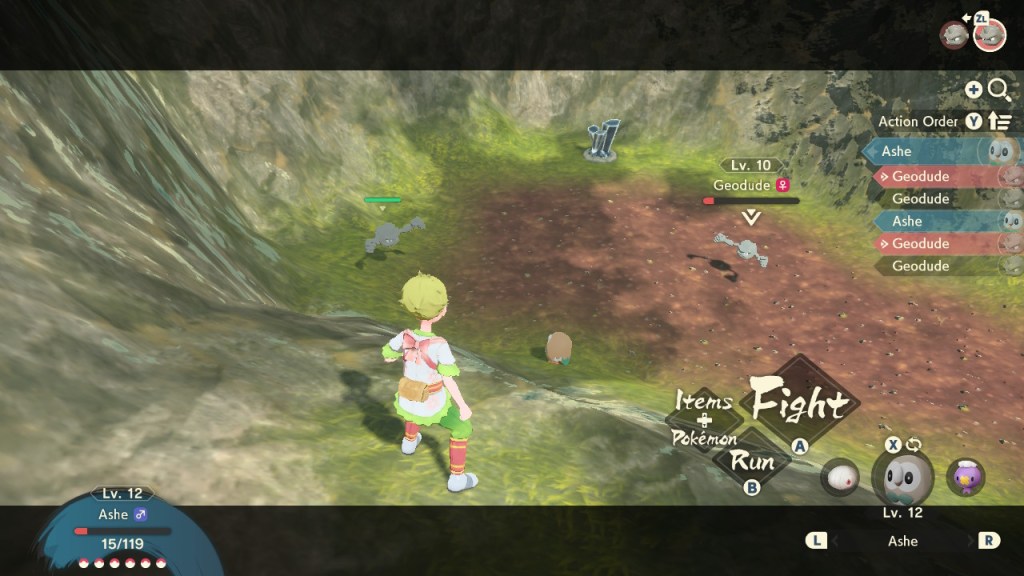
Different species of Pokémon behave differently in the overworld – this is true up to a point in Sword and Shield’s Wild Area as well, but Legends does a lot more with it, which adds a touch more realism to the world. Some Pokémon like Bidoof are totally docile; they won’t attack you unless you challenge them and won’t flee if you try to catch them. Some Pokémon like Shinx and Buizel are aggressive; they’ll attack you on sight, and once they’re in a mood to fight, they can’t be captured unless you challenge them with one of your own Pokémon – but you can be sneaky and throw a Pokéball before they know you’re there to catch them without a fight. Some Pokémon like Starly are skittish and will fly away if they see you, so you have to be sneaky with them. Abra can sense your presence telepathically from outside your normal throwing range and will immediately blink out; I haven’t figured out how to catch them yet. Drifloon can teleport short distances to dodge your throws or get closer to you. Stantler are timid, fast and have supernatural senses that make them very tricky to approach by stealth. There’s a lot of variety, is what I’m getting at; there is an element of figuring out each Pokémon’s behaviour individually, which I think is very cool and immersive.
What else, what else, what else…?

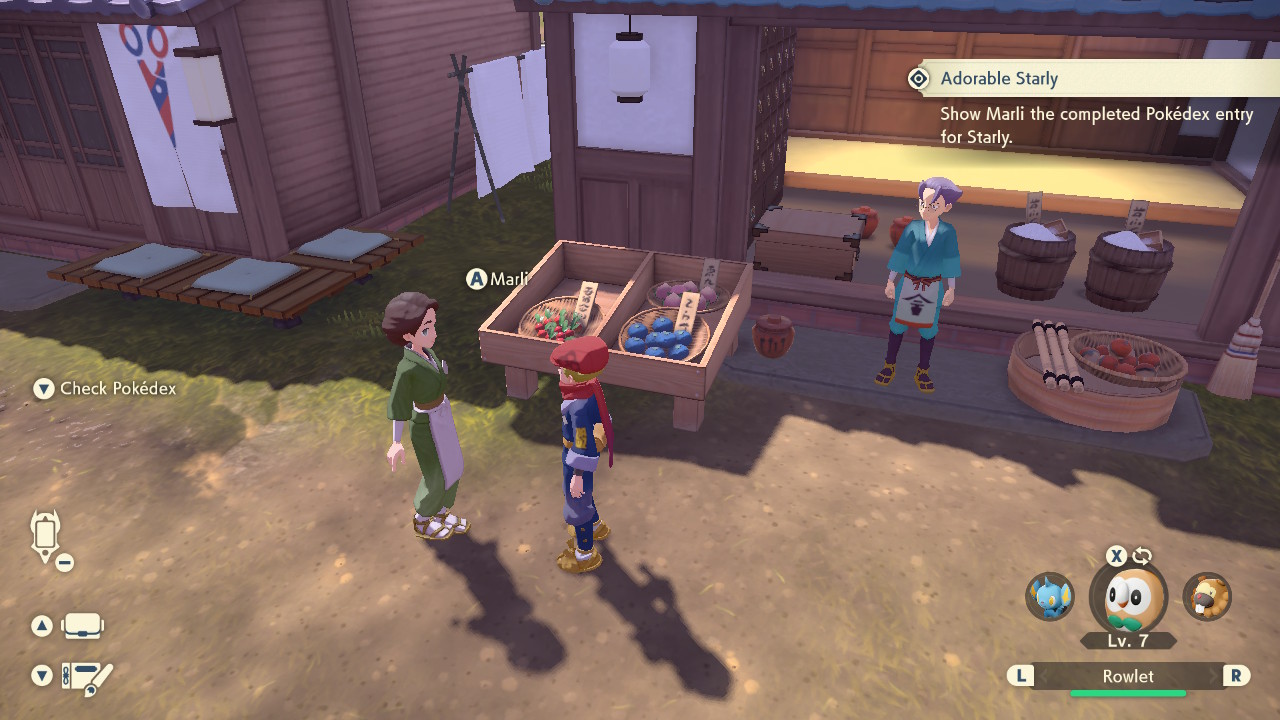
So this is a small thing, and maybe it’s a silly thing, but I like that everyone in Jubilife Village has a name. It just makes the town feel slightly more real and lets you get slightly more attached to it. Their dialogue also gives you a sense of what their schtick is – like the guy in this screenshot, Morel. If you meet him in town and talk to him, you learn he’s interested in mushrooms (a morel is a kind of mushroom; they’re the ones that look like honeycombs), then later he shows up at your base camp outside the village asking for help collecting mushrooms, and you think “oh, right, he’s the guy who’s really into mushrooms; that makes sense.” Marli thinks Starly are really cute, but is scared of them, because Pokémon are unpredictable and dangerous, and heck, Starly pack a hell of a wallop for such small and flimsy-looking animals; part of the Survey Corps’ mission is to help people like her to learn that it’s possible to live alongside Pokémon safely. It’s nice that they are characters, even if they are very minor characters, rather than just Townsperson #22 or whatever, and it’s nice that we are doing things specifically to help them. After all, as Cyllene emphasises, you fell out of the sky, no-one knows who you are, and you’re trying to make a home and a life for yourself in this town; relationships should matter even if they’re not the focus of the game.
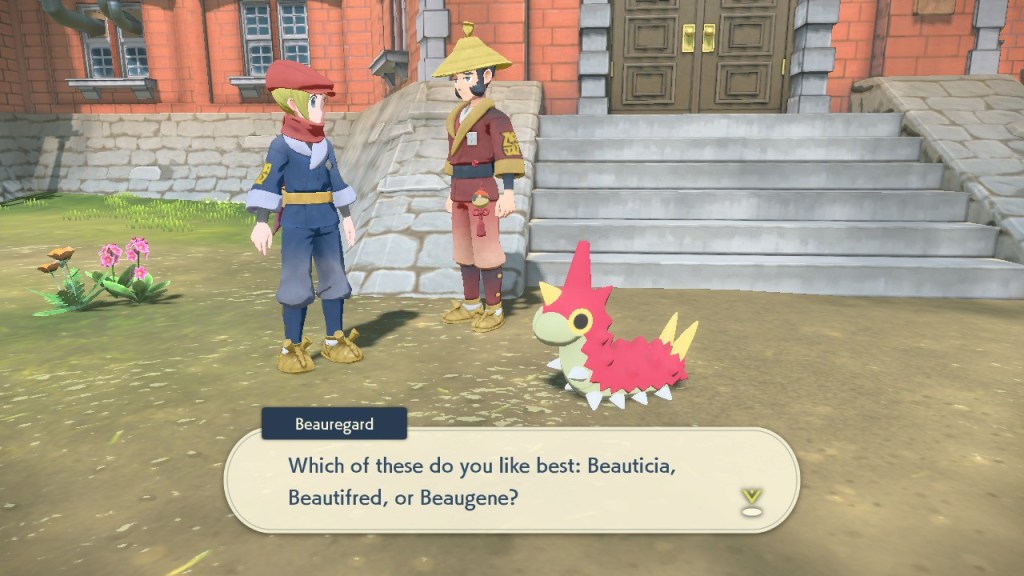
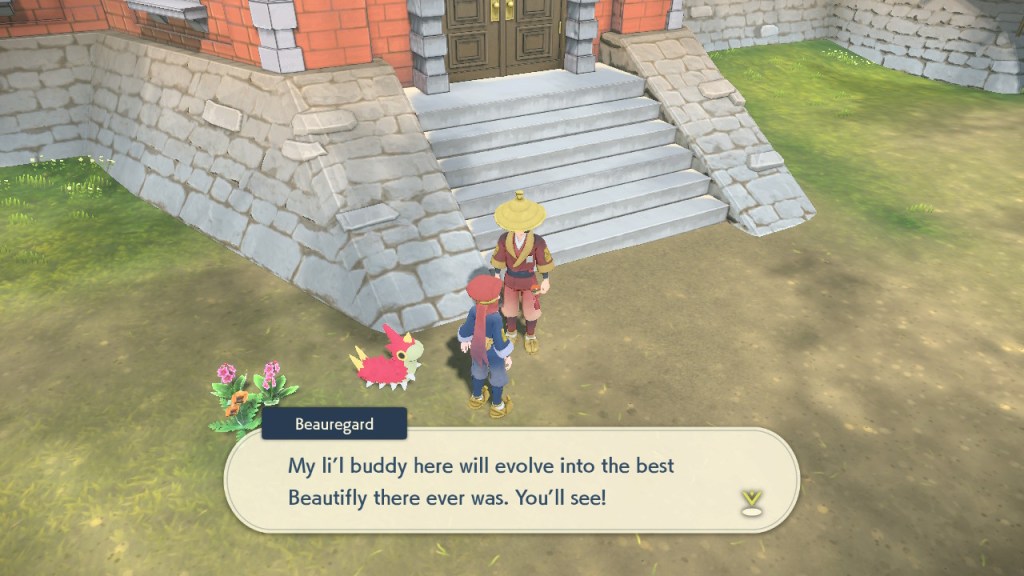
lol the Wurmple I caught for this n00b is totally gonna turn into a Dustox, isn’t it
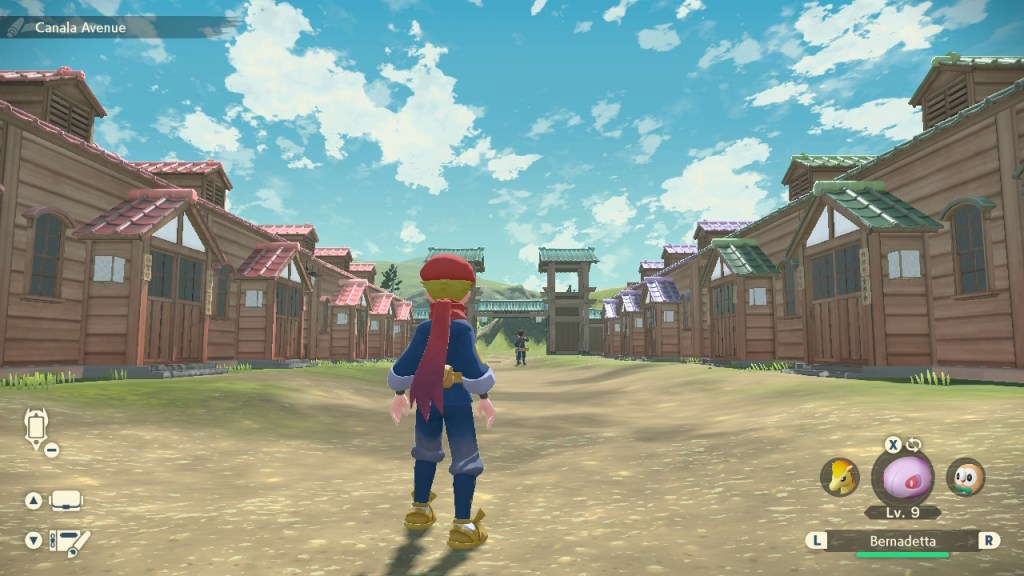
Some more minor things I quite like – the two main streets of Jubilife Village are called Canala Avenue and Floaro Main Street, presumably in reference to the two towns adjacent to Jubilife City in present-day Sinnoh: Canalave City and Floaroma Town.
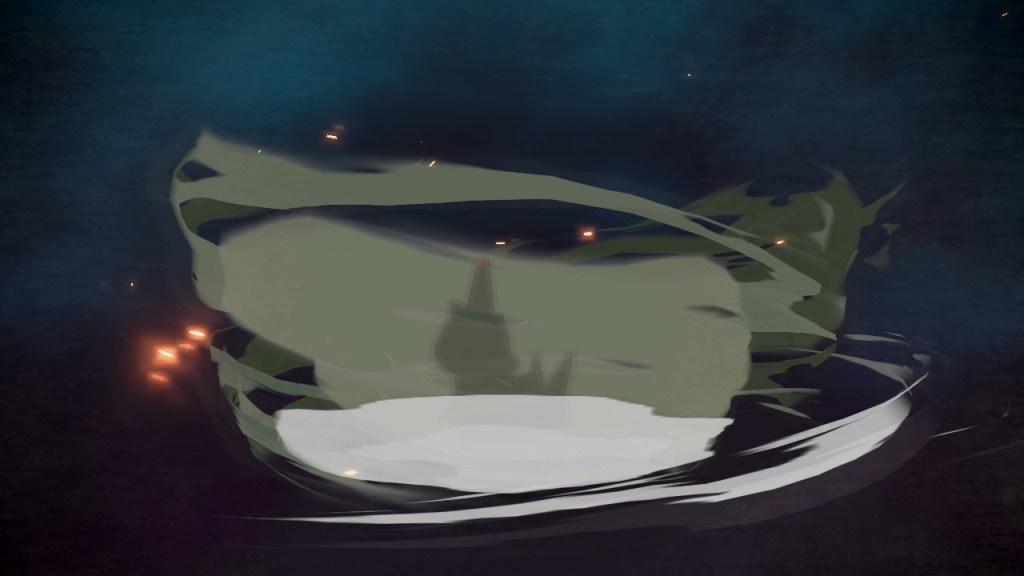
The animation for Pokémon evolution has this dark whirlwind with sparks and ominous flashes, and the Pokémon itself turns completely black with glowing yellow eyes; it’s less bright and wondrous than previous evolution animations. This is a setting where most people are scared of Pokémon, so it makes sense that even the cute ones would sometimes do something… well, a little bit scary.
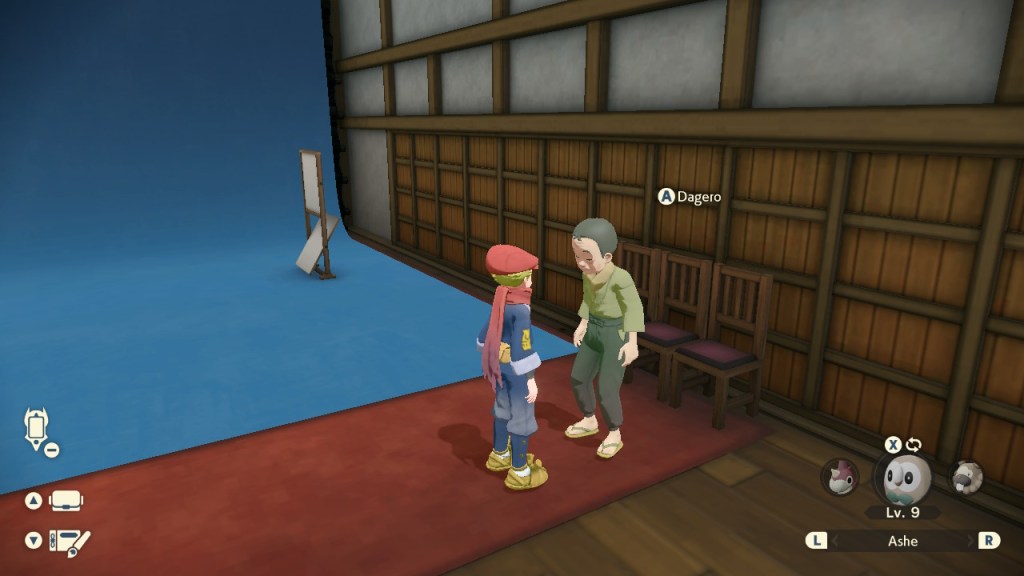
This dude who operates the photography studio where you can pose alongside your Pokémon is named Dagero – presumably in reference to Louis Daguerre, the inventor of early “daguerreotype” photographic technology (another detail that places Legends: Arceus not in the very distant past, but in the mid-to-late 19th century).

but mainly Bidoof
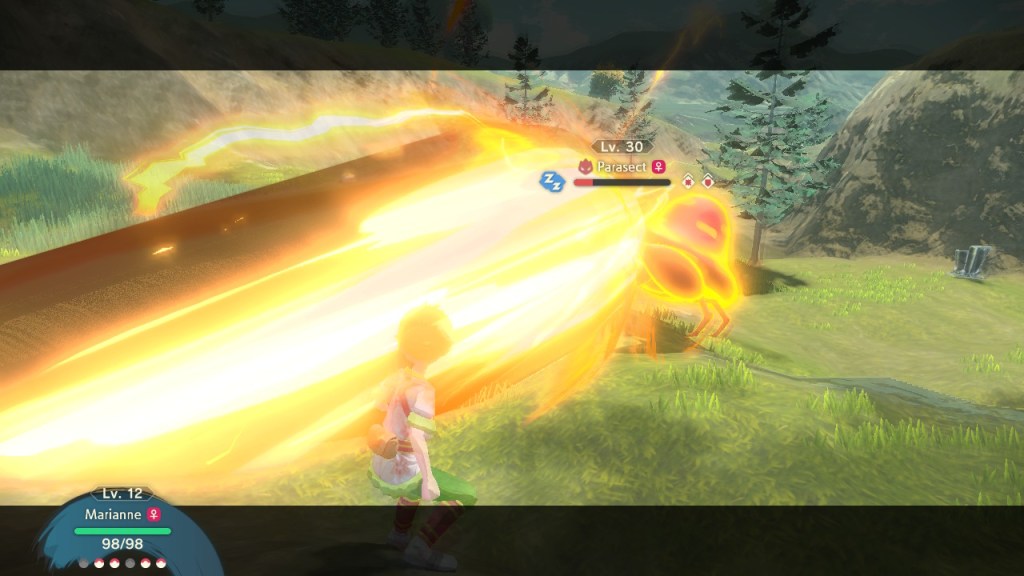
BIRD JESUS CHRIST

what have I gotten myself into
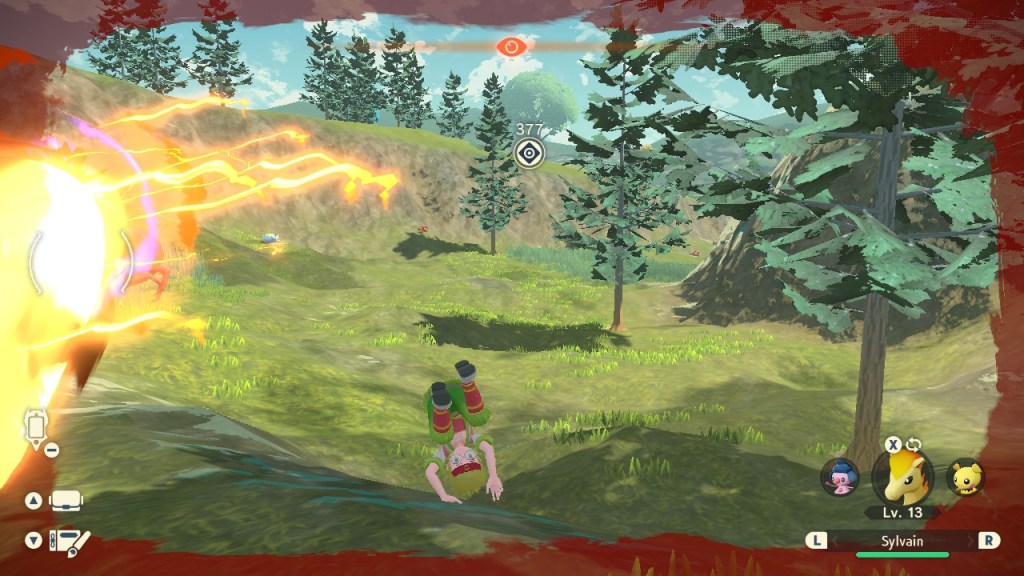
So, this Parasect trying to kill me is an “Alpha” Pokémon, which are Pokémon of Unusual Size. According to the indigenous people, they belong to special bloodlines, whose ancestors were blessed in ancient times by Almighty Sinnoh. However, they are sometimes a bit of a pain.
Also, this game has a plot.
The plot involves these nice people.
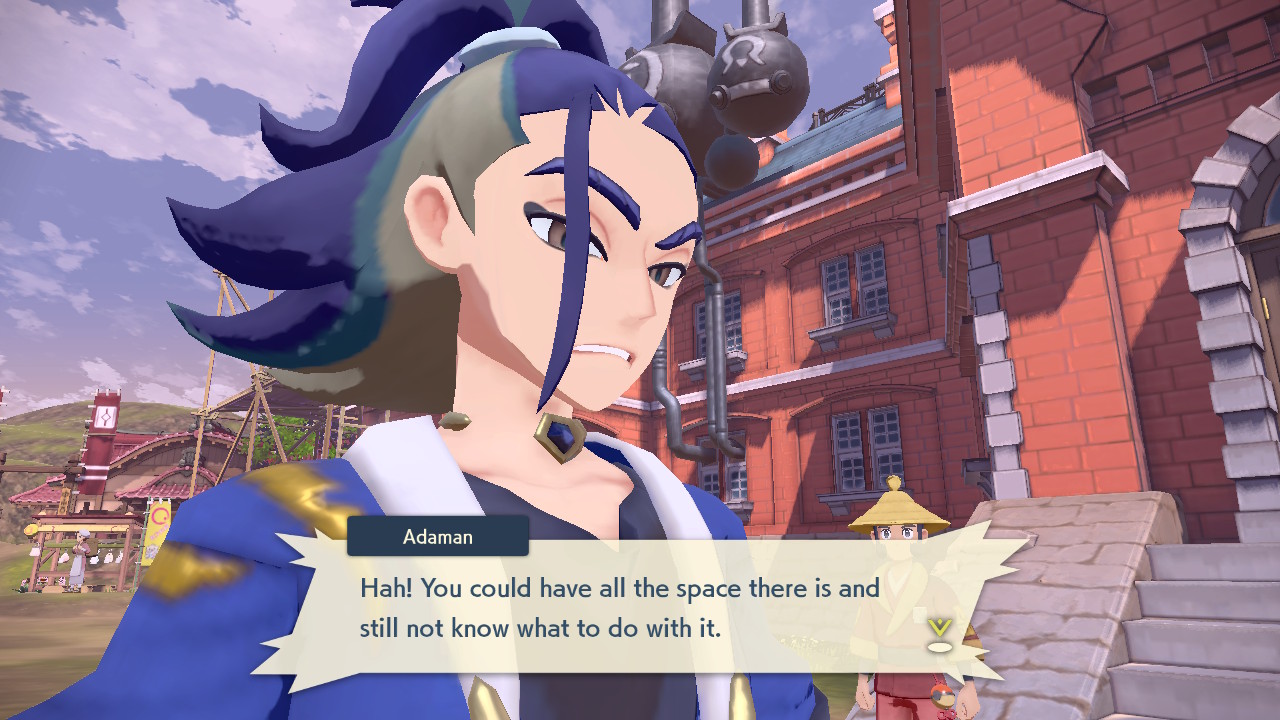
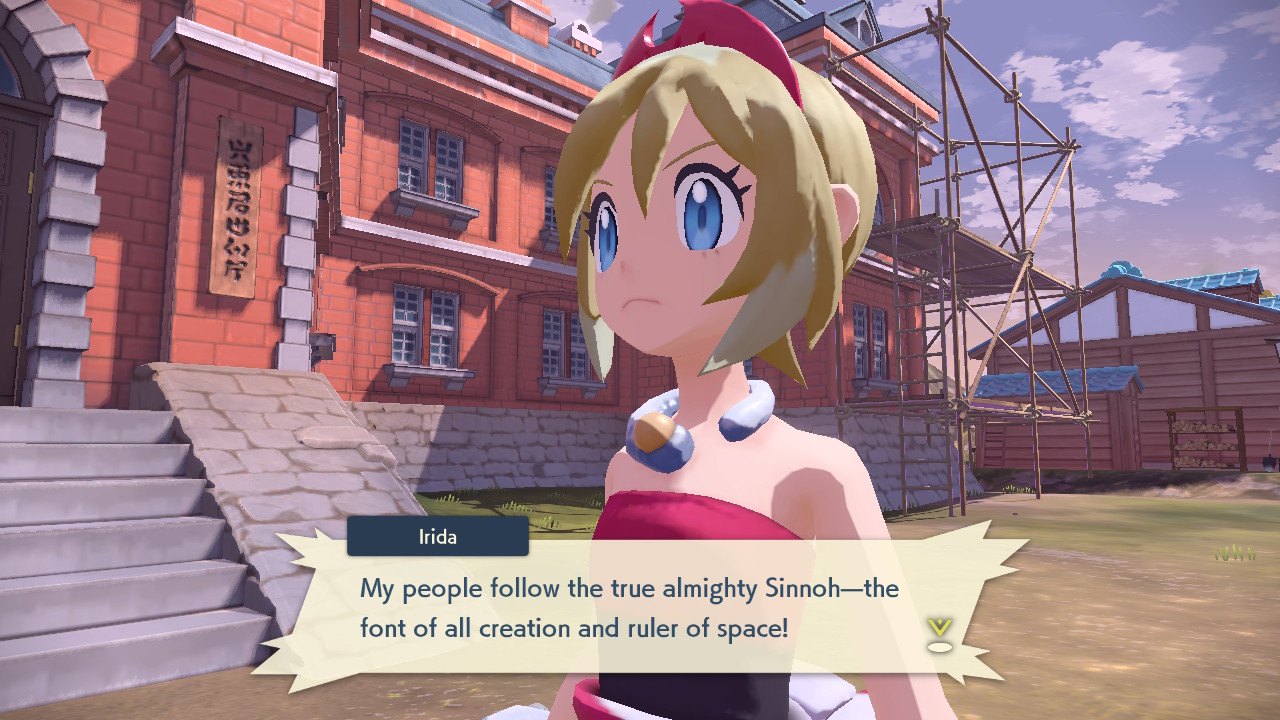
The Diamond Clan and the Pearl Clan are two rival factions of the native people of Hisui, and both of them get along better with the settlers than they do with each other. In the past, their relationship has apparently degraded to the point of open violence, and everyone is understandably somewhat anxious to make sure that this doesn’t happen again.
They both worship “Almighty Sinnoh,” but the two clans understand its nature very differently – the Diamond Clan see it as the ruler of time, and the Pearl Clan as the ruler of space. This apparently filters through to several differences in their philosophies and worldviews. To the Diamond Clan’s leader Adaman (see Greek adámas, “diamond,” but also an adjective “unbreakable,” hence the English “adamant,” “adamantine,” “adamantium,” etc.), living in accordance with the will of Almighty Sinnoh means being punctual and efficient – that is, never wasting time – so he gets annoyed with people who don’t pay time the same respect. By contrast, while the Diamond Clan seem to think confining Pokémon in balls is just “silly,” the Pearl Clan’s leader Irida (see Latin īris, “rainbow,” hence English “iridescent,” like a pearl) actually seems to take offence at it on some level, because she doesn’t like restricting Pokémon’s space – although she’s not so bothered by it that she won’t listen to the settlers’ perspective. Both Adaman and Irida insist that the other clan worships a “false Sinnoh,” and that only their own clan understands Almighty Sinnoh’s true nature. It sort of sounds like they might be describing Dialga and Palkia, in the mistaken belief that they’re talking about the same entity. Each of them believes that their deity is the true creator god, which reminds me of some of the Diamond and Pearl dialogue (from back before Arceus was officially revealed) implying that each game’s mascot legendary is the creator of Sinnoh. Both clans know an awful lot about the region that the settlers don’t (after all, they have been living there for a very long time), but the implication is that neither of them has the full picture on the Deep Lore stuff, and we’re going to need help from both groups to figure out what’s really going on.
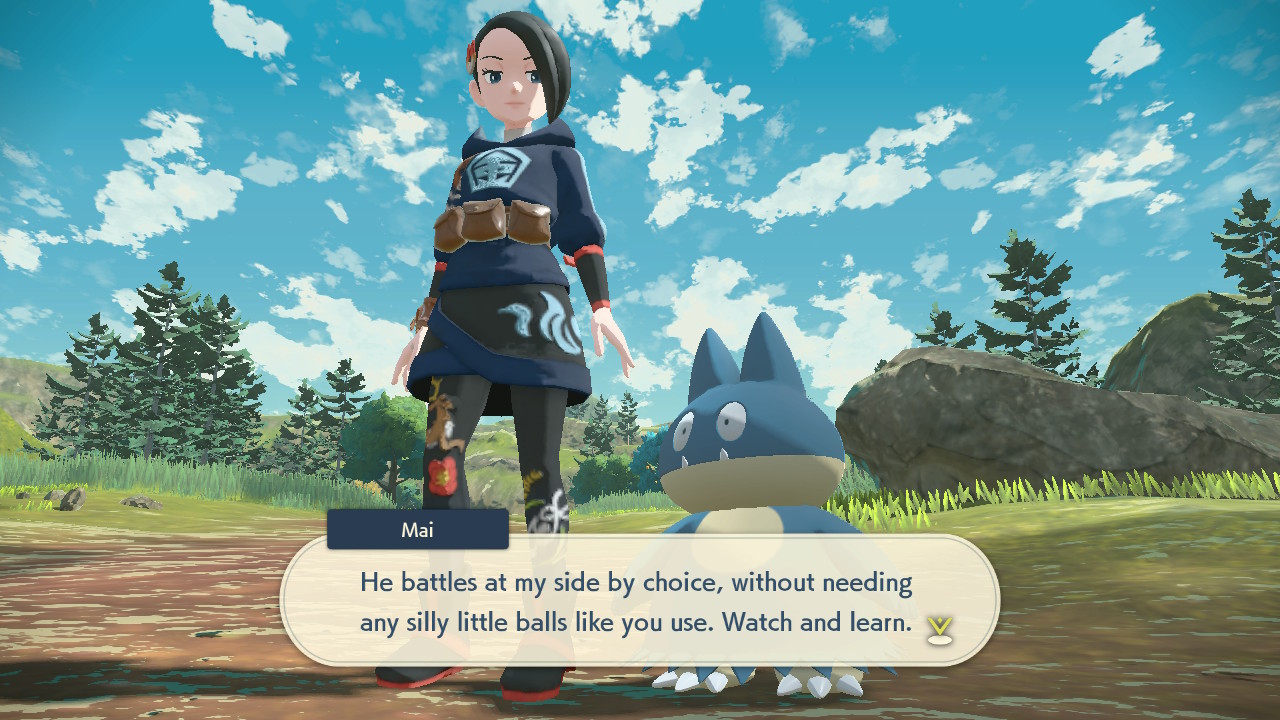

Both clans have people called Wardens whose job is to take care of the material and spiritual needs of special Pokémon, the “noble lords” of the lands of Hisui, who are also descended from holy bloodlines favoured by Almighty Sinnoh (whoever that is, and whatever that means). So far, these relationships seem roughly similar to the Totem Pokémon and island deities of Alola and their Captains and Kahunas. The first one we meet is a Diamond Clan Warden named Mai, whose lord is Wyrdeer, the unique regional Stantler evolution we were shown in some of the promotional stuff. The second is Lian of the Pearl Clan, who serves Kleavor, the unique Scyther evolution. Mai needs our help because some dumbass Alpha Pokémon is encroaching on Wyrdeer’s territory and she has to kick it out; that’s easy enough, and apparently earns us Wyrdeer’s favour as a special bonus, which is nice because Wyrdeer gives rides to people he likes.
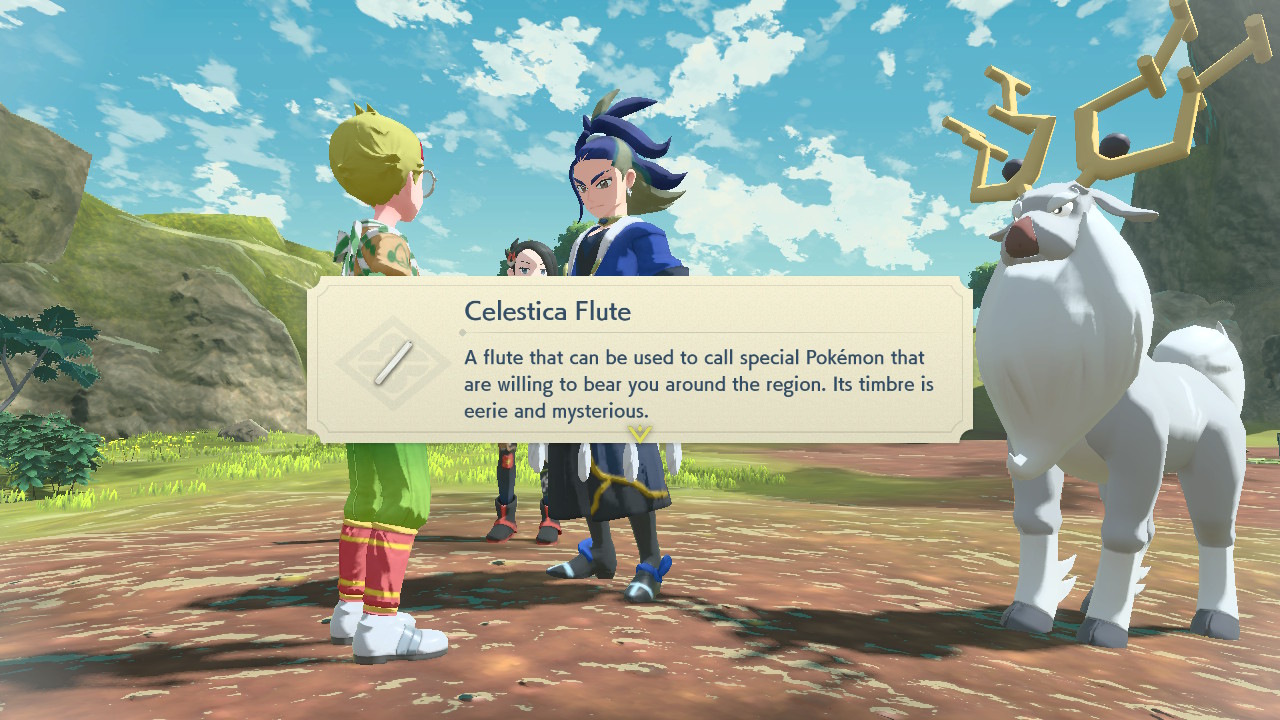
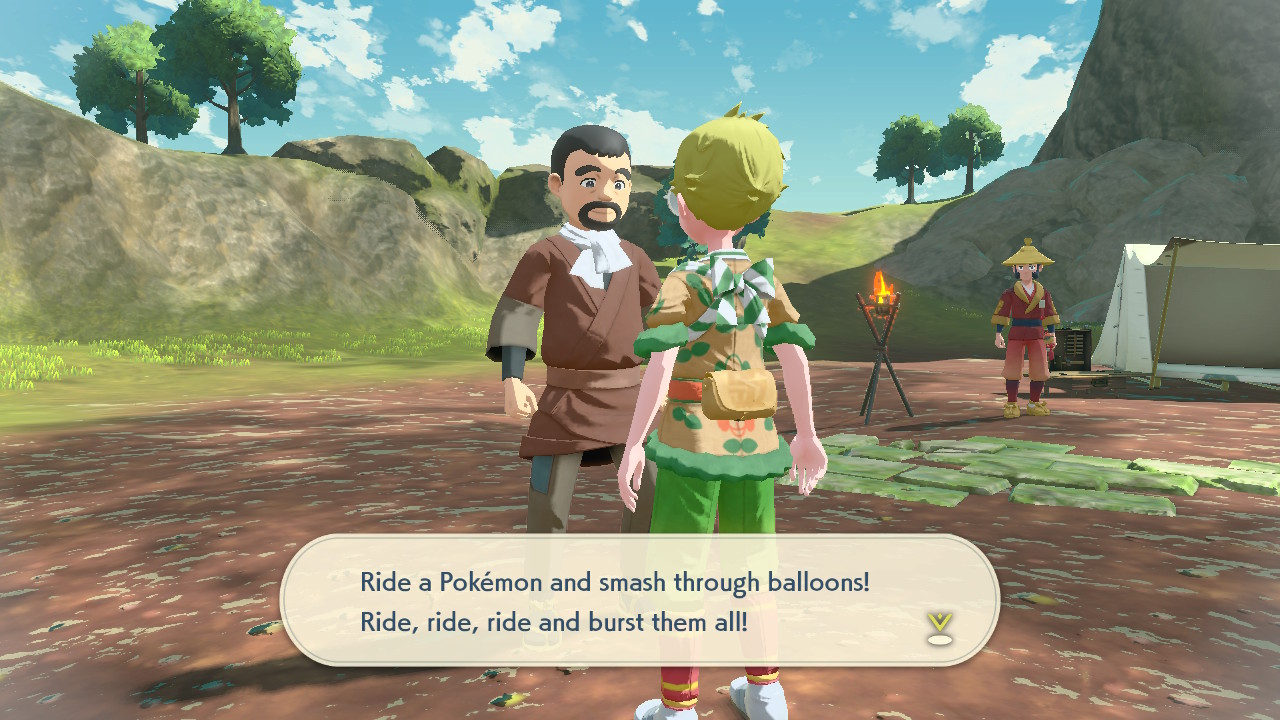
Gonna be honest, dude, that seems like a very frivolous use of this sacred privilege I’ve been granted.
Lian’s problem is a bit more serious. Apparently Kleavor’s gone nuts, attacking people who come near and not responding to Lian’s usual ritual offerings. That leads to a delicate political problem: the Pearl Clan can’t fight their own lord to figure out what’s going on, but it would also be disgraceful to let their hereditary enemies, the Diamond Clan, fight him.
Fortunately, we don’t give a $#!t about any of that.
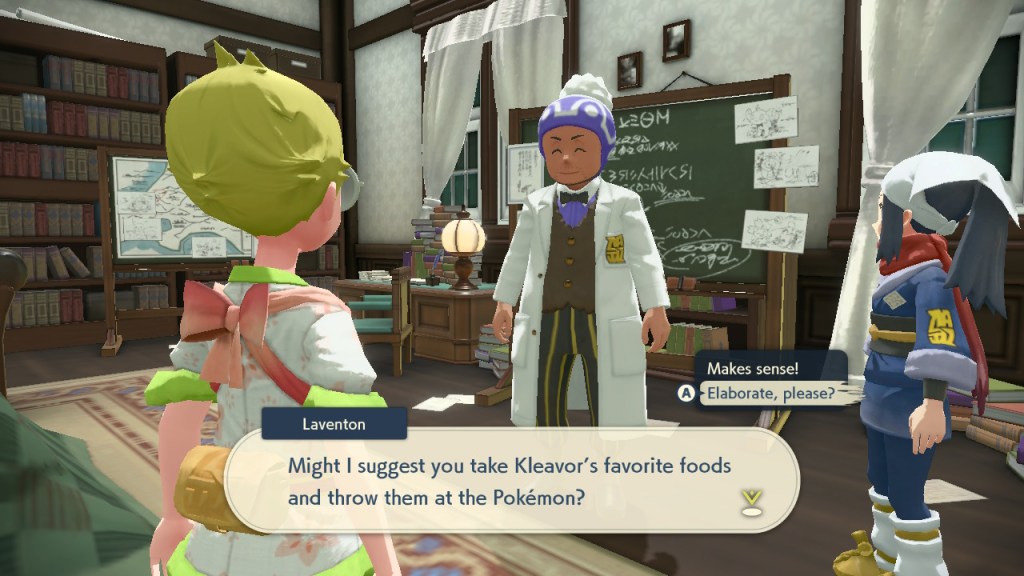
Let’s go get in a food fight with a giant bug.
[Also, while we’re here, a special thanks to my long-suffering Patreon supporters, the excellent Name (Required), Intonyeon, Miame Irohara, James Crooks, Esserise, Leo M.R., hugh_donnetono, Hamish Fyfe and, newest but not least, PLCM]

ayyyy Legends Arceus! I’ve wanted to play this game for a while but can’t because I don’t have a Switch, so seeing you go through it is great. That Wurmple in the screenshots looks bigger than I imagined them being. I wonder if sizes are more true to the pokedex in this game, it’d be more clear how big everything is. Think the previous games shrank down large pokemon to fit them into the screen.
LikeLiked by 1 person
Wurmple is supposed to be about 30 cm tall and it looks a little bigger than that to me in Legends, but not outlandishly so. Then again, it’s kinda tough to judge these things precisely by eye, especially when we don’t know exactly how tall our own character is.
LikeLike
The thing is, sizes in this game aren’t static. They are assigned a value that places them within a range, with bigger deviations being rarer (alpha Pokemon have that value set to 255, the max, meaning they’re automatically as big as that species can get). And the models very clearly reflect the ranges when next to each other – an early quest requires you to catch a Buizel that’s specifically over 2’8” (which is rare).
As far as I’ve seen, the in game scale is pretty fair. The size variation is crazy though, I’ve seen pictures of people standing next to a Lopunny that seems to be 7-8 feet tall.
LikeLike
I think the Alphas are well outside the normal range. I caught a good couple of dozen Buizel trying to get one for that quest, and never found one larger than 2’7″. Then I caught an Alpha and it was nearly 5 feet. I’m not sure the models of normal non-Alpha Pokémon actually do vary in size, or if they do I haven’t noticed? Might have to investigate that.
LikeLike
They absolutely do, but it’s often less noticeable
LikeLiked by 1 person
I’m really, really trying to not be a [censored] here but,
it seems Game Freak (right?) have made all this effort to make polished, high-quality video game; they’ve done a twist on the formula, introduced a new approach to the franchise and worked real hard to make this something much more than a cheap gimmick and succeeded brilliantly
and I’m just so surprised
LikeLiked by 1 person
I think for me it’s more of a “see, I *told* you you could do it!”
LikeLiked by 1 person
Honestly I sort of assumed they weren’t allowed.
LikeLike
Also entirely possible
LikeLiked by 1 person
“when Game Freak’s developers imagine a magic space-deer plucking you out of your normal life and dumping you in 19th century Hokkaidō surrounded by monsters, they don’t imagine your phone getting lost or becoming useless”
This feels like the sentence you should have used in the tweet. Just saying, it’s bizarre enough even with the proper context.
LikeLiked by 1 person
I *am* quite proud of that one…
LikeLike
I just finished the main story and am quite interested on your takes. While this game certainly feels like a breath of fresh air, and the gameplay itself is quite fun and engaging, it also feels very unpolished. Particularly on the graphics.
Also, Rowlet FTW!
LikeLiked by 1 person
Honorable mention: I’m actually glad to see the Forces of Nature (formerly a trio, now a quartet) imported to Sinnoh/Hisui in Legends Arceus. Aesthetically I’m still not a fan of their Incarnate Formes, but lore-wise, I always felt Tornadus, Thundurus, & Landorus were a better fit for Sinnoh & had been hoping they would be retconned for some post-Main Story campaign in an eventual Diamond/Pearl remake. My prayers to Arceus were finally answered in Legends Arceus; plus we even got another “genie” & Therian Forme so that the four together allude to the Four Auspicious Beasts from Chinese astrology.
PS: this trip down memory lane –
LikeLiked by 1 person
Controversial opinion: I never felt Mespirit / Uxie / Azelf were truly the regional trio because they share more than whatever differentiates them. I felt that perhaps Mespirit, Uxie, & Azelf needed to be Psychic/Fire (Emotion), Psychic/Electric (Knowledge), & Psychic/Ice or Psychic/Dragon (Willpower) to further differentiate them thematically & competitively, or perhaps each have move sets or signature moves tailored around a different elemental type.
LikeLiked by 1 person
Fun fact: Due to the Galaxy Team being analogous to the Hokkaido Development Commission, the ‘colonization’ of Hokkaido occurring *very* late, and other details (Laventon’s camera being the 1914 Leica 1, Palina’s dress being the sheer white of ‘ama’ divers of 1929, etc.), Legends likely takes place around 1931, meaning the cut lore about Poke Balls could very well *still* be canon (Mai refers to Poke Balls as a relatively new development, after all).
LikeLike
Doesn’t the Hokkaido Development Commission put us pretty firmly in the 1870s?
LikeLike